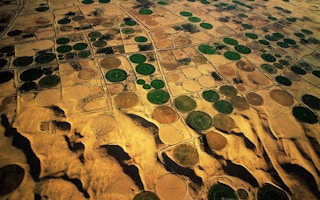Salim Ghrassia graduated in statistics five years ago and then opted for a rather different career: joining Algeria’s push to farm the Sahara desert.
“I saw the agricultural boom, and decided that was the path to take,” said 30-year-old Ghrassia as he walked through his plantation of tomatoes and potatoes at El Oued, an oasis some 700 kilometers (435 miles) southeast of Algiers. “We’ll have a good harvest again this year because we’ve got everything needed for success: water, sun and good seeds.”
As the International Monetary Fund and World Bank call on Algeria to diversify its economy from oil, the government is stepping up efforts to boost agriculture in the country’s south with concessions and cheap loans for farmers like Ghrassia. Officials want to keep the threat of the region’s Arab Spring at bay by creating jobs in an impoverished and restless area, while curbing the need for food imports of $8 billion a year.
That ambition is driving the cultivation of one of the harshest environments on the planet — a landscape where the heat limits laborers to toiling just four hours a day until 9 a.m. Challenges also include the dependence of subsidies and infrastructure costs on stable oil prices, climate change, depleting one of the world’s biggest underground natural water reserves and educating farmers in more advanced techniques.
“Results, measured in terms of growth in domestic production, are very impressive,” Maurice Saade, an economist at the World Bank, said in an e-mailed reply to questions. “Agriculture will continue to grow robustly.”
Farming expansion
Agricultural production expanded at an average annual pace of 7.3 percent in the decade through 2010, more than twice that of the prior 10 years. It employs about 14 percent of the workforce in a country of 37 million people, compared with 2 percent in oil and gas, the economy’s lifeblood.
“Agriculture, apart from hydrocarbons, is the sector that is working the best,” Central Bank Governor Mohamed Laksacitold reporters this month.
El Oued is the focus of government efforts in the south, which starts at the Atlas Mountains and covers about 90 percent of Algeria’s land area. The climate fosters two harvests a year, compared to just one in the north, and last year it yielded produce worth $1.7 billion.
North of the whitewashed, domed houses of El Oued city lies Hassi Khelifa, where former teacher Bekar Ghemam Hamed has 100 hectares on a remote off-road plantation.
Circular pits
He grows wheat, potatoes and barley in circular pits dug deep in the sand, a method of forming mini oases used for centuries to cultivate date palms. He and other growers clubbed together to pay for the creation of dirt tracks linking their farms to the main road, and for electric cables to pump ground water.
“The government needs to do more here, like it does in El Oued,” Hamed said. He produced 7 tons of wheat per hectare last year, four times the yield in the north.
Saade of the World Bank bases his forecast for strong growth in agriculture on government plans to increase irrigated land to 1.6 million hectares by 2014 from 1.1 million hectares, and likely investment from the private sector.
President Abdelaziz Bouteflika’s ruling National Liberation Front is nurturing higher domestic agricultural production to reduce reliance on imports that drove up food prices and sparked unrest. The government has used higher subsidies to appease protesters and help prevent Arab Spring-inspired uprisings.
Hicham’s things
That policy has strained state finances at a time when oil production has dipped to a 10-year low and exploration projects slowed amid security fears after the al-Qaeda attack on the An Amenas gas plant in January. Algeria would need an oil price of $121 per barrel to balance its books, the IMF estimated in November. Brent crude reached a high of $118.90 a barrel in February and dipped as low as $97.69 in April.
With oil and gas representing 40 percent of the economy and agriculture less than a 10th, the government is intensifying its farming initiative to make up the shortfall.
Hicham Mahmoudi is cashing in. He owns a farm shop called Hicham’s Things, in Mizraa, 60 kilometers east of Biskra, a former Roman outpost three hours drive from El Oued city known for its wholesale fresh produce market.
“More and more people are coming from the north to try their luck here,” Mahmoudi said, breaking conversation to explain to a steady stream of customers that he sold out of tomato seeds. “This is a really profitable niche for me.”
Back in El Oued, where temperatures soar as high as 43 degrees Celsius (109 degrees Fahrenheit), Ghrassia’s tomato plants are flourishing, along with crops of potatoes, watermelons, peppers and grapes. He started small, and then convinced his four brothers, who hold university degrees in economics and business, to join him. They now have 55 hectares among the sand dunes and want to plant olive trees when they enlarge the farm next year.
“I could have had a good desk job with my degree,” Salim Ghrassia said. “But I don’t regret a thing.”










